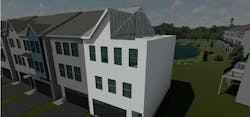Of course there’s way more to building modular housing than craning a cartridge off the flatbed and assembling the pieces like Lego blocks.
The onsite ground crew has to be ready to move so the crane operator doesn’t have to wait. Should the builder work with the local jurisdiction or hope for a third party to handle inspection, and are there finishes and other loose ends completed in the field that can be installed in the factory? Those are some of the issues that Van Metere Homes is jumping after its first run with constructing POWERhaus, a three-story, 2,700-square-foot townhome made of 13 individual cartridges and eight panelized walls.
Paul Jester, vice president of market intelligence at Van Metre Homes, says that while this prototype didn’t deliver cost savings, it’s taking the company in the direction that it needs to go. For one, it is ultimately a better home, because it is more efficient and higher quality. It also has technology that residents will expect in the near term because it adds so much value. Such as the Alarm.com system that will detect a leak and shut it off, potentially saving hundreds if not thousands of dollars.
“We’re still in research phase and not quite ready to scale,” said Kevin Rabil, executive vice president. “We plan to keep analyzing how to perfect the model. We will need more factory space, which is definitely a huge obstacle.”
The next step for Van Metre is to build four townhomes together, which will provide a better scale to figure out the cost components. Through that process, the builder will integrate subs and materials to analyze every inch of the house and how to put it together in the warehouse and onsite in a more efficient manner.
“We’re trying to make sure there is an upfront design, upfront communities, and perfect product before putting more expenditure in warehouse space,” Rabil said. “When we know we have a runway, when we know what the cost is, that’s when we can support expenditure on warehouse space.”
